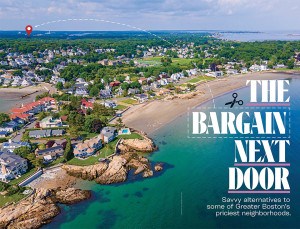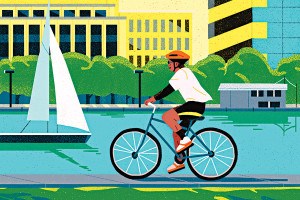How to Save Transportation in Boston: Big Ideas
Our transportation system is full of big problems in need of even bigger solutions. Here, transportation experts dish their most creative ideas.
Additional reporting by Spencer Buell, Jacqueline Cain, Brittany Jasnoff, and Alyssa Vaughn.

Photo by Michael Prince
Ride Above the Streets
Bill James
Founder and CEO, JPods
JPods are an overhead network of ultralight vehicles that carry people and cargo from origin to destination using a tenth of the energy of cars, trains, and buses. Solar collectors at the top of the rails gather the energy to power the networks, which look something like Ferris wheel cars hanging from monorails.
Our vision is that it will start at places such as Logan Airport, where it will connect the terminals to the T station, hotels, and car rental building. Then it will spread. Within four years, you will be within walking distance of one station, and get to a station within walking distance of where you want to go. Or you could scooter or Uber the last mile to a JPod station to get around Boston. We will build the network with private capital, operate it without government subsidies, and pay the city 5 percent of gross revenues. We could begin building if Massachusetts passes a bill sponsored by state Senator Patrick O’Connor, “An Act Relative to Solar-Powered Mobility Networks.”

Photo by Randi Freundlich
Put Roads on a Diet
Joe Curtatone
Mayor, Somerville
With the term “road diet,” I’m really speaking about how we humanize our roads: how we think about and plan our community for people, not just the automobile. If you plan a city for cars, that’s what you’re going to get. We need to reclaim the right-of-way for the people.
That can mean adding protected bicycle lanes to create the bicycle infrastructure we have today. Or simply putting paint on the ground and delineating where the bicycle infrastructure is. Or widening the sidewalks, and reclaiming asphalt for placemaking, which has incredible social and economic benefits for a community. It even means reclaiming the streets for housing: We have a development on the west side of the city that will take part of the roadway to expand affordable housing.
On Bow Street in Union Square, we changed to angled parking, which did three things: added more parking for the merchants; allowed us to put in a bike lane; and acted as a traffic-calming measure. On Broadway in East Somerville around the same time, our goal was for that street not to be the on- and off-ramp to Boston any longer. So we eliminated a lane of traffic in each direction, added bike lanes, and expanded the sidewalks. And what happened? Traffic was less congested, and our businesses can take advantage of more vibrancy on the sidewalks.
Change is never easy, but we’ve been inspired by community members who have come out in support of these measures, because they are based on a set of shared values. One of our goals is to shift mobility to 50 percent more biking, walking, and public transportation.
Transportation is a regional crisis, like housing and climate change. There are great opportunities across communities in how we can connect those projects to have greater benefits. We’ve seen the benefit of that from Cambridge, Somerville, Brookline, and Boston working on the Bluebike system. I chair the Metropolitan Mayors Coalition, which represents 15 cities in the inner core of Boston, and we are having these conversations now. We are talking with Medford about priority bus lanes on Mystic Avenue, and with Arlington about connecting those buses in a more efficient and equitable manner to transit stations like Sullivan Square.
The important thing is that we’re learning from these incremental steps taking place around this region and across the country. To have true impact, we need to have full systemic change.
Flying Machines
Gwen Lighter
CEO, GoFly
I spent three years of my life in Boston for law school and have spent most of my life in the New York/New England area, so I understand the density issue there. We need to go up to alleviate the congestion in our city centers and provide more viable, more sustainable mobility options.
GoFly has created a community of engineers, industry experts, and academics to solve this. The $2 million GoFly Prize has 854 competing teams from 103 countries creating personal flyers. They all look different and they all function in different manners. We are supported by Boeing, Pratt & Whitney, and Google Planetary Ventures, as well as the American Institute of Aeronautics and Astronautics, the Royal Aeronautical Society, and 18 other aerospace organizations around the world. The competition culminates in a grand final fly-off at NASA Ames Research Center in California on leap day: February 29, 2020. One small step for man, one giant leap for mankind. That will be the moment when the world will watch as we make people fly.
There will be flying platforms, which may be best for first responders to land in areas that were inaccessible previously. Certain types of flyers might be better for package delivery, others for personal commutes. We have a number of teams designing flying motorcycles.
There are major companies working on flying taxis, where people go to a rooftop, get into a large flyer, and go to another spot in the city. Boston might have point-to-point travel from your home to your office or restrict it to skyport-to-skyport in certain areas.

Photo courtesy of NAACP
Mobility for the People
Tanisha Sullivan
President, Boston NAACP
Transportation is an issue that goes far beyond reducing emissions or whether the train is bright and shiny. It really should be about addressing our economic disparities, our affordable-housing crisis, and even our education disparities. Greater access to transportation enhances quality of life.
To achieve this, some of our public transportation should be fare-free for students and seniors. We should also consider flat rates for commuter rail—rather than penalizing people who live farther outside the major metropolitan areas. There should be incentives for families and companies to be more creative in how they think about transportation options. I propose a tax credit on trade-ins for electric cars; it’s not just about adding a new car to your household’s fleet, it’s about getting that fuel-operated vehicle off the road as soon as possible. Likewise, to get people out of rush-hour traffic, we need to incentivize more companies to actively promote, through financial benefits, the use of flexible-working schedules. We talk about where we live, we talk about where we work—we also need to talk about how transportation affects the time we spend with family and the time we spend with community.
Ride the Harbor
Alice Brown
Director of planning, Boston Harbor Now
Today, it’s really hard to take public transportation from East Boston to the Seaport, or to the Navy Yard in Charlestown. We’ve proposed a new star-shaped ferry route for the inner harbor. As part of that, I’m especially excited by the prospect of rebuilding Lewis Mall next to Maverick Square to be a full ferry-dock facility. The people of East Boston will have a ferry, not only to go to Long Wharf, but to Charlestown and the Seaport.
People are rediscovering the harbor in so many ways. They’re already out on the water in water taxis, ferries, and shuttle boats. We just need to expand where publicly accessible boats go.

Photo by Marilyn Humphries
Think Outside the Box
Jim Canales
President, Barr Foundation
Based on the work that we have done and the partnerships we have funded over many years now in the mobility space, what’s evident is that there is no silver bullet and no single fix. So what I end up focusing on is: What are some of the values and principles that should inform how we think about solutions? And there are a number of things that I would land on.
One is that we should think a lot about how we put people at the center of whatever solution we’re trying to advance. How do we think about what people fundamentally need in order to get to the places that they need to go? I think another element that is important for Boston, which aims to be a world-class city, is how can we ensure we are aspirational and bold as we shape the kind of mobility system that a world-class city deserves? Sometimes we can get stuck in these conversations about “Well, that’s not possible,” “Our system is so old,” or “We don’t have the money to do it.” I’m hoping that we can really think big, bold, and aspirationally, and acknowledge that it’s also going to take time and resources and that it’s not going to get solved overnight.
Consider Dockless Bikes and Scooters
Lama Bou Mjahed
Research director, Mobility Lab
Shared dockless e-scooters and e-bikes could be a really viable way to enhance mobility in Boston, based on our study of Arlington, Virginia’s pilot program. The results show that people don’t just use them recreationally, as was predicted, but to go to destinations, such as shops or work, or make connections to metro rail.
Companies that operate the shared-bike programs in Arlington paid a fee to the city, and deployed them across the county. Riders use an app to scan the code to unlock one. There’s usually a $1 fee to unlock it, and then a fee per minute; the average cost is around $3 for the scooters. When you’re done, you park it, usually on the sidewalk. The city can use corrals to de-clutter the sidewalks; Arlington has seven now and is rolling out more. Of users surveyed, 32 percent said e-scooters and e-bikes replaced cars for them, whether Uber or private vehicles. So there is the potential to take cars off the road.
Roll With Robotaxis
Karl Iagnemma
President, Aptiv Autonomous Mobility
Self-driving “robotaxis,” which are currently operating in Las Vegas, will one day increase accessibility in Boston. Autonomous vehicles are without bias; they do not discriminate based on where people live, their income level, or their race. For underserved communities, they provide low-cost connectivity to reach transit lines.
Imagine a Boston with an efficient network of vehicles that are deployed only when there is demand, moving seamlessly to and from destinations, helping people better travel to transit stations, healthcare facilities, school, and job opportunities. That means improved mobility, reduced congestion, safer roads, and equitable access.
We have a fleet on the road in Las Vegas that’s picking up and dropping off passengers six days a week, and so far we’ve given more than 75,000 rides to members of the public. We don’t have a specific timetable for Boston yet, but we plan to ramp up significantly in the middle of the next decade.
Teamwork Makes the Dream Work
Patrick Sullivan
Executive director, Seaport Transportation Management Association
Because transportation affects all of us, it can bring people to the table who might not otherwise collaborate. I propose fostering stronger partnerships both among neighboring businesses that share many of the same transportation challenges, and between the public and private sectors. It’s really interesting how willing businesses are to take that call, take that meeting, and be of assistance.
On the South Boston waterfront, for example, our organization brought together business leaders, along with leaders from city and state agencies, to launch the Seaport–North Station ferry service in February of this year. The state agency, the Massachusetts Convention Center Authority, led the effort to procure the boats and figure out how to operate the service. A mix of employers and property owners in the Seaport came together to 100 percent privately fund the service, which serves their employees and the public. Related Beal, which owns Lovejoy Wharf, constructed the dock, which received some public funding. Today we’re seeing 14,000 riders per month—and six buses that were previously making dozens of trips a day between North Station and the Seaport are off of the road.
Listen to the Users
Ambar Johnson
Program director, LivableStreets Alliance
It’s so important for people to be able to connect safely and efficiently to transit centers that will take them to and from their jobs. The “last mile” concept can make or break transportation. And it’s the community that knows what obstacles they face to get to that next spot.
When we are doing this work, whether it’s state agencies, cities, or municipalities, it is integral to make sure that the process is community-driven. There is so much knowledge that community members hold, being so proximate to the issues they’re dealing with every day. In some cases, yes, we need new technologies. But really it gets as simple as, what if we just listen to community members, and get the things that they’ve been asking for done? There are things they’ve been asking for for years: more frequent service along Columbia Road; lower fares on the Fairmount Line; more connections, with lower transfer times; not having a road in their community treated like a highway, so that their children cannot safely cross the street. Listen and trust their judgment, and just implement it.
Invest in Gateway Cities
Tracy Corley
Transit-oriented development fellow, MassINC
For too long we have been designing our communities so that all of the activities are concentrated in major metropolitan hubs such as Boston, and everywhere else is just housing. That is what is causing congestion. By revitalizing our gateway cities and making them hubs of activity, we can ease people out of traffic on our roads and lower usage on our rail systems.
There are three ways to make that happen. First: more diverse employment opportunities close to home in those gateway cities, led by small-business development.
Second: Strengthen our Regional Transit Authorities (RTAs). We need not only those first- and last-mile connections to rail and other infrastructure, but also alternatives to cars for getting around in people’s own communities. That includes more frequent and reliable bus service, but we also need to empower RTAs to think systematically about ways to coordinate and collaborate with other communities—for example, providing one-seat rides between those gateway cities.
Third: Allow regional ballot initiatives so that gateway cities and surrounding communities can raise their own funding to address local transportation needs. Right now, transportation is centrally planned and gateway cities are really getting left behind. There is a bill being considered in the legislature for this.
Appoint a “Mayor of 128”
Amy Dain
Transportation policy analyst, Dain Research
There’s a lot of demand for housing in the municipalities along the Route 128 corridor. But we’re continuing to build isolated developments that are only accessible by cars. If we build places that are walkable or have other means of transit, then we will reduce the amount of car use for the people who live there.
There’s a real opportunity there, but we need people who are thinking about that region, and devoting their careers to it, and feeling responsible for it. Who right now is responsible for 128? We could use an unofficial mayor. Think of Vivien Li, the longtime “mayor of Boston’s waterfront,” as a model.
The Mayor of 128 could help view development in a different way. What’s the infrastructure we need to get people walking from place to place, taking the train, taking shuttles, and riding bikes, or maybe taking a kayak down the Charles River to your job? How do we set up regional mitigation funds and funding to upgrade stations? We need somebody whose whole career is devoted to it, thinking about it, pushing it—and doesn’t just come up with a plan and then move on to the next project.
Interviews have been condensed and edited for clarity. Additional reporting by Spencer Buell, Jacqueline Cain, Brittany Jasnoff, and Alyssa Vaughn.


